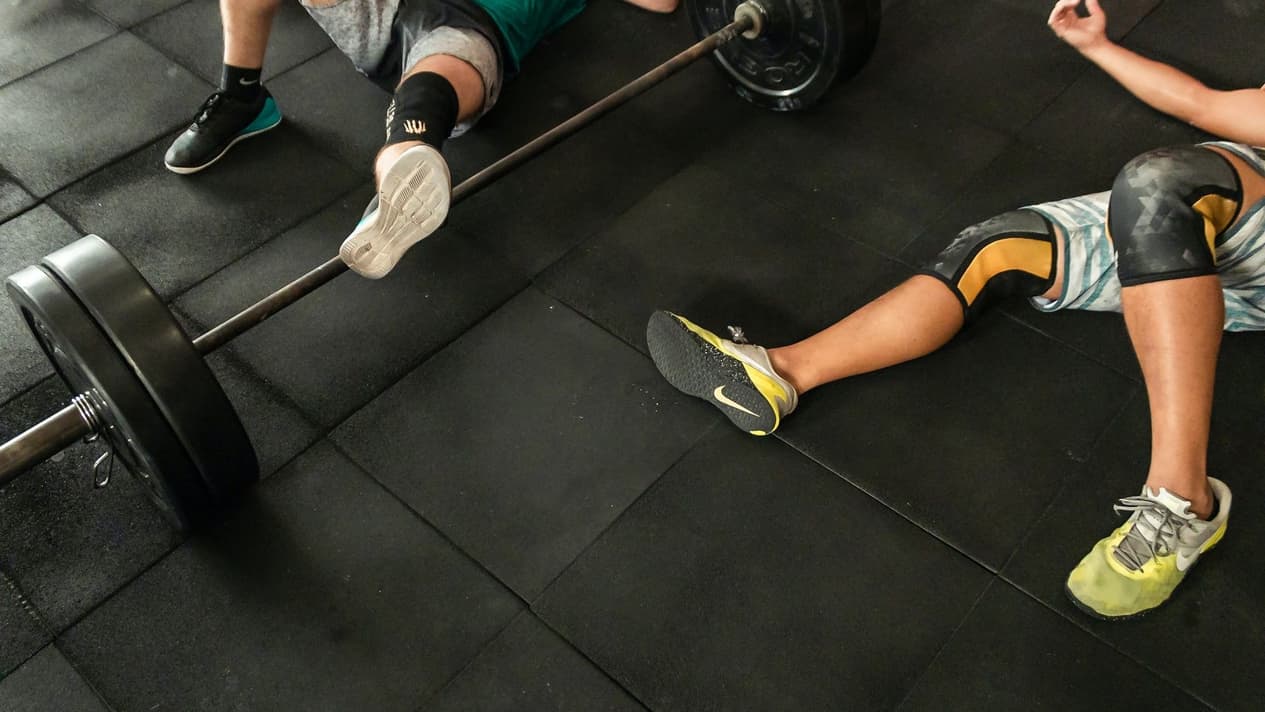It can be too easy to over-exercise or overtrain without even realising! There are several reasons why we do this. We can get so caught up with reaching a fitness goal, addicted to seeing results and wanting more, or training for an upcoming competition that we ignore the signs and signals from our body to slow down.
There are several reasons for excessive training or exercise. For athletes, the pressure to perform, the pressure (and drive) to win, and the pressure from sponsors can push them to overtrain.
For everyday fitness fanatics, we may over-exercise for personal reasons. Sometimes we try our best to do 6 months’ worth of weight loss in two weeks for a special event. Maybe it’s a wedding, a holiday to Dubai, or perhaps you’re planning on ‘accidentally’ bumping into your ex and planning on flaunting your revenge body. For whatever reason, sometimes we can overdo our training and exercise excessively. But how do we know if we’re overtraining? And what does overtraining look like?
Am I Overreaching or Overtraining?
We need to distinguish the difference between overreaching and overtraining. There comes a time with our training when we expose ourselves to a much higher training load- one that we typically can’t sustain over time. We’ll purposely increase the volume and intensity of our training load in order to stimulate changes in the body, in order to increase performance. I.e., We start lifting heavier weights to increase our muscle mass, which hopefully results in increased strength and performance.
Overreaching is when we reach too much with our training. Overreaching is considered an accumulation of training load that leads to a decline in performance requiring days to weeks for recovery ( 1 , 2 , 3 , 4). Functional overreaching (i.e., overreaching done correctly) is a necessary part of development and progress ( 5). It is when we push ourselves, or overreach, to the point where our performance eventually declines. However, with adequate rest and recovery, you’ll ultimately adapt and improve to levels better than before in a process known as supercompensation (6, 7).
Functional overreaching is what we desire when looking at training, recovery and improved performance, but we have to be careful not to cross the line into overtraining.
It’s not hard to become addicted to exercising and training with the effects of endorphins, dopamine, and other exercise-generated factors on the brain. This addiction can easily result in repeated intense training sessions that don’t include enough recovery periods. This places individuals at increased risk for developing a non-functional overreaching state and, in more severe cases, overtraining syndrome ( 8 ).
What is Overtraining?
Overtraining is when training exceeds one’s ability to recover and adapt ( 9 ). Overtraining (also known as Chronic Overtraining Syndrome) occurs when we ignore the signs of overreaching and continue repetitive intensive training without adequate recovery. It involves the accumulation of stress, mental and physical, leading to a decrease in physical and mental performance in sports and exercise and can take up to several months to recover ( 10, 11 , 12, 13 ).
Sometimes our mental toughness can mistake weakness or poor performance as a signal to push through and train even harder, but this only breaks the body down even further. And though it’s admirable to train hard to succeed with your training or exercise goals, too much training without sufficient recovery can hinder your progress — and even lead to a decline in your performance.
For some, it may be hard to know when you’re overtraining. You’re expected to feel somewhat fatigued after a challenging training session, but feeling like you aren’t recovering between sessions or experiencing overall and prolonged fatigue and difficulty pushing yourself during workouts can be signs of overtraining.
Signs and Symptoms of Overtraining
Here are some common signs and symptoms of overtraining ( 14, 15 , 16 , 17).
Training-related Signs of Overtraining
- Decrease in performance despite an increase in effort
- Unusual muscle soreness after a workout, and lingering aches and stiffness in joints and muscles which persists with continued training
- Performance plateaus or declines
- Not reaching the same gains you used to get in the early stages
- Inability to train or compete at a previously manageable level
- Delays in recovery from training
- Loss of training enthusiasm
- Thoughts of skipping or cutting short training sessions
- Limbs, especially legs, “feel heavy”
- Decrease in coordination and inability to concentrate
Lifestyle-related Signs of Overtraining
- Feeling excessively tired and prolonged fatigue
- Poor-quality and disrupted sleep- waking up unrefreshed
- Increase in tension, depression, anger or confusion
- Lack of energy and decreased motivation
- Loss of enjoyment with training or exercising
- Increase in irritability
Health-related Signs of Overtraining
- Immune system alterations- Prone to getting sick easier and/or more frequently
- Increased blood pressure and elevated resting heart rate
- Digestive upset
- Loss of appetite and unintentional weight loss
- (For men) Loss of sex drive and libido.
- (For men) Testosterone levels may decrease
- (For women) Oestrogen levels may decrease
- (For women) Irregular menstrual cycles; missing periods
- Being in a depressive state (not clinical) such as sadness, low mood, tearfulness
How to Recover from Overtraining
Full recovery from overtraining is difficult and can require weeks or months off from working out ( 18).
If you suspect you’re overtraining, a short break and regression of the training plan should be implemented. Trying to power through overtraining can make matters much worse and could require a longer break from exercise ( 19 , 20). Recovery from overtraining includes:
Rest, Rest… and then Rest Some More
Rest is crucial for recovery from overtraining. You may need to temporarily stop or cut back on your training.
Good Nutrition
Excessive training and exercise combined with a poor diet is a recipe for burnout and chronic overtraining syndrome. Make sure your nutrition is on point with an emphasis on ensuring that your body is receiving all the calories, macros and minerals it needs for high-intensity training. Work with a nutritionist to evaluate your food habits and make sure you’re getting enough of what you need. Prep Kitchen provides a great selection of nutritious meals suited for the active gym-goer or athlete.
Mental Health Care
Keep your stress down by implementing things like meditation, and try to find enjoyment with activities outside of the gym
For an athlete who spends most of their time training or a fitness fanatic who enjoys working out, it can be very emotional and challenging to take time off from training.
Mental health professionals can help with recovery from overtraining by offering a safe space to discuss your feelings and concerns. Getting support and validation can help normalise the experience and help you feel less overwhelmed or discouraged to take breaks. Mental health professionals can also provide skills and techniques to help with psychological healing during the breaks, such as mindfulness and visualisation.
Slow Return to Training
Your trainer, coach or health care provider should guide you back into training when they feel it is fit for you to do so.
It’s important to not jump back into full training too quickly as this could lead to a prolonged recovery. Your training volume may be reduced by at least 50 to 60 per cent, and depending on how you feel, increase by about 10 per cent each week.
The recovery will be different for every athlete, so It’s important to be aware of symptoms with progression.
Visit your Health Care Provider
Consider talking to a doctor or health care provider if you have signs and symptoms of overtraining. They can provide you with specific information on your recovery and/or refer you to a medical specialist.
How To Prevent Overtraining
The best fix for overtraining is to avoid doing it in the first place. Here are some points for preventing overtraining ( 22, 23 ):
Reduce Training Load
In terms of exercise and training, have a de-load week- maybe once every six weeks- where you reduce the volume of the training load for that week. This gives the body time to heal and repair itself.
Listen to Your body
The niggles you feel in your muscles or joints; the limbs feeling ‘heavy’; disrupted and bad sleep; these are all ways your body is communicating with you. Listen to your body and work closely with your trainer, doctor or coach and let them know how you’re feeling.
Schedule Rest days and Rest Periods
Effective training requires a balance between intense training sessions and periods of rest and recovery ( 24 ). Too much overload and/or not enough recovery can result in both physiological and psychological symptoms that limit performance and may cause a lack of motivation and enjoyment with your training or exercising. Schedule regular rest days after long or demanding workouts.
During training or a workout, have rest periods. Rest intervals can be anywhere from 30 seconds to 6 minutes, and, if needed, reduce the volume and intensity of your sessions.
Schedule Active Rest Days
Incorporate active rest days with low impact activities such as walking or swimming. Low impact activities can help relieve muscle tightness and help you stay active while recovering from a strenuous workout.
Acknowledge when you’re overdoing it — and talk to someone about it
If you find yourself becoming obsessed with training, exercising through injury or pain, or feeling guilty if you go a day without intense exercise, then talk to someone about your feelings. It’s important to have a healthy relationship with exercise.
Monitor Feelings with Training
We’re mostly good at noting how our training is going, whether we hit a new PR (personal record) or PB (personal best), but we don’t tend to note down our feelings associated with our training or exercise. By monitoring our feelings with exercising and training load we can recognize the signs of overtraining and reduce the load to prevent overtraining.
Balance Training with Recovery Time
Rest is not a sign of weakness! We need at least one day of rest every week. As the saying goes, train hard but rest harder!
Eat Right!
Ensure your calorie and/or macro intake is sufficient for your training, repair and recovery needs. Eat a well-balanced diet with plenty of carbs, protein, healthy fats, and fresh fruits and vegetables. Check out our meals at Prep Kitchen for our range of delicious healthy meals!
Manage Stress
When your stress levels exceed your ability to cope, your body will begin to break down. Find ways of de-stressing such a meditation, or treating yourself to a massage.
Sleep
Sleep is your bodies best time for recovery and repair.
To Sum Up
When you're an athlete or fitness fanatic, and love what you do and are truly dedicated to working out, it becomes easy to ignore the signs of overtraining until they get too loud.
Overreaching is what we desire with our training because although it results in a temporary decline in performance, with appropriate periods of recovery a positive supercompensation effect occurs, with the athlete exhibiting enhanced performance. When our training exceeds our ability to recover and adapt and we continue repetitive intensive training without adequate recovery, we fall ill to overtraining.
Put simply, overtraining is good. Overtraining is bad.
Healthy sleep, nutrition and mental wellness are critical in preventing overtraining. These must be part of the training programme just as much as the exercise and rest plan.
Bottom line, if you want to get better and improve performance, you need to schedule adequate rest in your sessions, and then rest some more.
Author - Paulo Vaa




